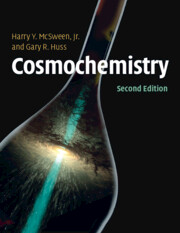Book contents
- Cosmochemistry
- Cosmochemistry
- Copyright page
- Dedication
- Contents
- Preface
- 1 Introduction to Cosmochemistry
- 2 Nuclides and Elements
- 3 Origin of the Elements
- 4 Solar System and Cosmic Abundances
- 5 Presolar Grains
- 6 Meteorites, Interplanetary Dust, and Lunar Samples
- 7 Element Fractionations by Cosmochemical and Geochemical Processes
- 8 Stable-Isotope Fractionations by Cosmochemical and Geochemical Processes
- 9 Radioisotopes as Chronometers
- 10 Chronology of the Solar System from Radioactive Isotopes
- 11 The Most Volatile Elements and Compounds
- 12 Planetesimals
- 13 Chemistry of Planetesimals and Their Samples
- 14 Geochemical Exploration
- 15 Cosmochemical Models for the Formation and Evolution of Solar Systems
- Appendix: Some Analytical Techniques Commonly Used in Cosmochemistry
- Glossary
- Index
- References
6 - Meteorites, Interplanetary Dust, and Lunar Samples
Published online by Cambridge University Press: 10 February 2022
- Cosmochemistry
- Cosmochemistry
- Copyright page
- Dedication
- Contents
- Preface
- 1 Introduction to Cosmochemistry
- 2 Nuclides and Elements
- 3 Origin of the Elements
- 4 Solar System and Cosmic Abundances
- 5 Presolar Grains
- 6 Meteorites, Interplanetary Dust, and Lunar Samples
- 7 Element Fractionations by Cosmochemical and Geochemical Processes
- 8 Stable-Isotope Fractionations by Cosmochemical and Geochemical Processes
- 9 Radioisotopes as Chronometers
- 10 Chronology of the Solar System from Radioactive Isotopes
- 11 The Most Volatile Elements and Compounds
- 12 Planetesimals
- 13 Chemistry of Planetesimals and Their Samples
- 14 Geochemical Exploration
- 15 Cosmochemical Models for the Formation and Evolution of Solar Systems
- Appendix: Some Analytical Techniques Commonly Used in Cosmochemistry
- Glossary
- Index
- References
Summary
Compositions and classification of chondritic and differentiated meteories and of interplanetary dust particles
Keywords
- Type
- Chapter
- Information
- Cosmochemistry , pp. 110 - 138Publisher: Cambridge University PressPrint publication year: 2022
References
Suggestions for Further Reading
There are a number of excellent (but rather technical) chapters in recent books that describe the classification of meteorites in greater detail than presented here. The following are highly recommended. All have excellent photographs, but some of these resources probably offer more information than most beginning readers can use.

